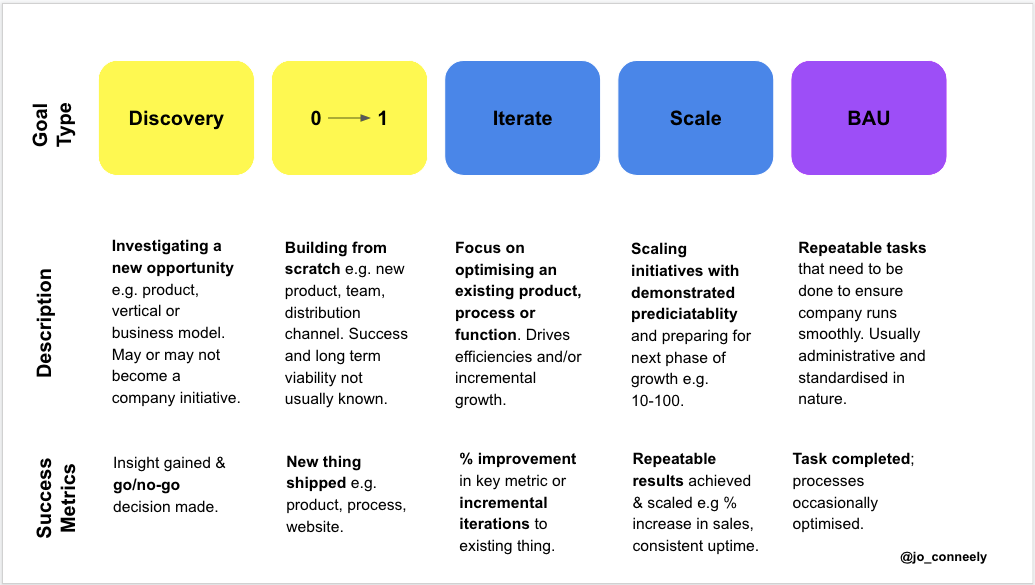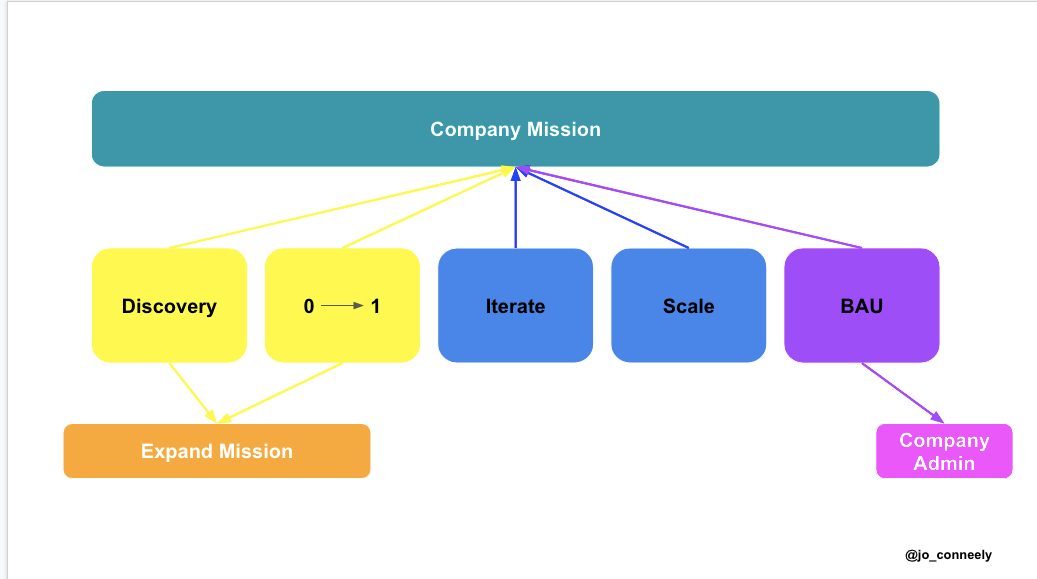OKRs aren't the only way. How to identify the right types of goals for your team.
It’s June, which means for many companies it’s H2 planning time. A glorious season, where we look back at the goals we set at the end of the previous year. Unperturbed by the fact that many were abandoned, missed or quite simply a waste of time, we return to repeat the cycle with unbridled optimism thinking, this time things will be different. Someone is tasked with ensuring that each team actually sets goals. That cross-functional dependencies align. That there is some method in place to track progress. That person was usually me.
I’ve spent an inordinate amount of time trying to devise the perfect goal planning process. I used to be an OKR evangelist, proclaiming their virtues with a fervour that John Doerr would be proud of. I have since come to realise that there isn’t a one size fits all goal setting approach that works for all teams.
Once your startup has scaled beyond the initial founding members you’ll start to introduce multiple teams. These teams will be of varying levels of maturity. What success looks like for a 20 person maturing engineering team, will differ to that of a fledgling sales function or the solo People operator. Different teams have different focuses, different operating models and different definitions of success. Setting the right types of goals on a team level is important. Much more important than having goals that fit neatly into a company level OKR tracker. Too often, teams spend far too much time focusing on writing the perfect SMART goals and not enough time on deciding if the type of goals they have chosen are the right ones in the first place.
What are the different types of goals?
Below I’ve identified 5 types of goals, which fall into 3 categories:
Doing something new: Discovery and Zero-to-One type goals.
Building on the existing: Iterate and Scale type goals.
Business as usual: The day-to-day work that is often overlooked and not classified as goals, but requires your team's bandwidth.
When a company is pre-product-market-fit, most of the work conducted will either be Discovery or Zero-to-One type initiatives. Over time, the business’ goals will vary across the spectrum, as will those of most teams. Being able to identify each goal type helps to align everyone on what a “good” outcome looks like at the end of the relevant time period. For example, if most of your teams are focused on Discovery work this quarter, then significant revenue gains are unlikely in the short term (ideally, they are identifying avenues for future growth). Conversely , if your teams are heavily indexed on Scale type goals, a good outcome would be the relevant charts inflecting up and and to the right 📈 , at an increasing pace.
How do these goal types tie together?
Your goals may not always line up to a well defined objective, as the OKR philosophy mandates. Your company goals should, however, help progress the company’s mission. If your company’s aim is to help people “Belong Anywhere” (Airbnb) or “Spread Ideas” (TED), then each team should be able to state how their goals enable people to better belong anywhere or spread ideas.
Of course there are always exceptions to the rule. You may be considering expanding the company’s mission. Particularly if the original one was somewhat restrictive. In this case some resources may be directed towards Discovery and Zero-to-One type goals focussed on the new direction that hasn’t been fully agreed or embedded as the overarching mission yet. Additionally, sometimes BAU work won’t align with progressing the company’s mission beyond ensuring the relevant company admin work is done to ensure the company isn’t shut down due unfilled tax reports and unpaid employees.
If you find that team goals aren’t aligning with the company mission it could be because nobody understands and/or buys into the mission. Drop all else and fix this immediately.
Common Goal Setting Traps
Below are several issues that can arise with each goal type. This list is non-exhaustive. One point to remember is that humans are setting the goals, and humans often let their own biases and preferences affect decision making. If you notice that a team primarily focused on Iterate type work has become quite bloated given the size of the organisation, you may have a perfectionist manager on your hands. Someone who, while well intentioned, is utilising a disproportionate amount of the organisation's resources because they can’t separate the work that can be “good enough for now” vs “important focus area for this stage of growth”. Or, you may have a political minded manager in place. Someone focused on empire building so that they can justify asking for that VP title next quarter. Always worth double checking.
How to think about the distribution of your team’s goals?
Each team’s goals will skew across the different goal types. Each team, even in the most BAU of roles, should at times look for new ways to automate their work or expand their capabilities. Every team in a growing organisation should dedicate time to iterating and scaling initiatives. Some teams will have less of a say in the types of goals they work on that others. This is typically the case for roles that work in service of Product and GTM teams (think Legal, Compliance, sometimes Finance). If you’re in one of these teams do flag concerns about workload in advance and ask for the resources you need. If ignored, don’t waste time on a lost cause. When issues ultimately arise, workloads will need to be reprioritised and that's a great time for headcount budgets to be rediscussed...
Moving beyond theory
I appreciate that dissecting goal construction into this level of granularity isn’t everyone’s idea of fun. However, you are likely going to spend hours planning said goals and months delivering on them. It’s worth taking the time (but not too much of it) to ensure your teams are starting off in the right direction and avoiding common traps. If you work in a startup or high growth company, then it’s inevitable that some of the goals will change as fires emerge. With that in mind I’ll defer to Eisenhower's wisdom on that thought:
“In preparing for battle I have always found that plans are useless but planning is indispensable.”





Hey - thanks for this; very thoughtful and timely indeed. I am wondering though whether you are confusing the type of goal (ie. Scale X) for the framework (or process) used to define and track the goal (ie. OKRs)? I see defining the type of goal and the success metrics as a key prerequisite step to defining and tracking the goal itself. And I absolutely agree that people tend to get lost in the process rather than focus on the outcome. That is an age-old story and it applies to all types of frameworks or processes, not just OKRs; agile is another example that comes to mind - most people try very hard to do agile by the book and they forget why they’re doing in the first place (or never actually know 😀) So defining the type of goal one thing ( tied to strategy) and using a framework to formalize and track another thing. No?